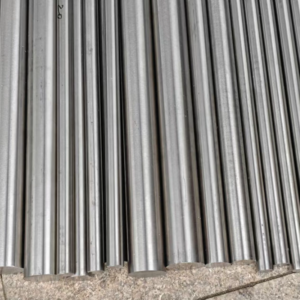Get in touch with us
Leave a message
Monel metal stands as the ultimate defender against harsh marine and chemical environments. This remarkable nickel copper alloy combines superior strength with exceptional corrosion resistance – particularly in seawater and aggressive chemical solutions. The unique Ni-Cu alloy composition delivers reliability where other materials fail. From chemical processing to marine engineering, Monel material maintains its integrity under extreme conditions. Our precision-controlled Monel alloy formulations ensure consistent performance in your most demanding corrosion resistant alloy applications.

Monel traces its origins back to 1905, when metallurgist Robert Crooks Stanley developed it for the International Nickel Company (Inco). Named after the company’s president, Ambrose Monell (with one “L” dropped due to trademark rules), this Monel alloy was patented in 1906. Initially derived from nickel ore mined in Sudbury, Ontario, its natural nickel-copper alloy composition inspired its creation. Over the decades, Monel evolved into a family of alloys, with variants like Monel 400 and Monel K500 enhancing its capabilities. Today, owned by Special Metals Corporation, Monel remains a premium Monel material for demanding applications.
Monel is standardized under various specifications, ensuring consistency across its grades. Common standards include ASTM B127 (plates), ASTM B164 (bars), and UNS designations like N04400 (Monel 400) and N05500 (Monel K500). Its classifications range from solid-solution alloys to precipitation-hardened variants, each tailored for specific needs. Whether you’re seeking Monel material specifications for marine or chemical use, these standards guide manufacturers and buyers alike.
At its core, Monel is a nickel-copper alloy with nickel (52-67%) and copper (up to 38%) as its primary elements. Small amounts of iron, manganese, carbon, and silicon enhance its properties. For example, Monel K500 adds aluminum (2.3-3.15%) and titanium (0.35-0.85%) for extra strength. This Monel composition ensures a balance of corrosion resistance and mechanical performance, making it a reliable Monel metal.
Monel comes in several forms, each with unique characteristics. Below is a table summarizing key variants:
| Type | Composition | Key Characteristics | Common Forms |
|---|---|---|---|
| Monel 400 | 63-70% Ni, 28-34% Cu, ≤2.5% Fe | Excellent corrosion resistance, ductile | Bars, sheets, pipes |
| Monel R405 | Similar to 400 + 0.025-0.06% S | Free-machining, good strength | Screw machine stock |
| Monel K500 | 63-70% Ni, 27-33% Cu, 2.3-3.15% Al, 0.35-0.85% Ti | High strength, age-hardenable | Rods, forgings, wire |
| Monel 404 | 52-57% Ni, balance Cu | Low magnetic permeability | Electronic components |
Monel excels in harsh environments. Here’s a breakdown of its chemical behavior:
| Property | Behavior | Influencing Elements | Notes |
|---|---|---|---|
| Corrosion Resistance | Outstanding in seawater, acids, alkalis | Ni, Cu | Resists chloride stress cracking |
| Oxidation Resistance | Moderate, weaker in oxidizing acids | Ni | Poor against nitric acid |
| Magnetic Properties | Slightly magnetic (400); non-magnetic (K500) | Ni, processing | K500 non-magnetic below -100°C |
| Heat Resistance | Stable up to 1000°F (538°C) | Ni, Cu | Retains strength at high temps |
This corrosion-resistant alloy shines in reducing environments but requires caution in oxidizing conditions.
| Property | Stainless Steel (304) | Carbon Steel | Aluminum |
|---|---|---|---|
| Tensile Strength | 621 MPa | 400–550 MPa | 90–300 MPa |
| Hardness (Brinell) | 170–200 HB | 120–200 HB | 15–95 HB |
| Ductility | High (40–60% elongation) | Moderate | High |
| Density | 8 g/cm3 | 7.8 g/cm3 | 2.7 g/cm3 |
Monel K500 outshines stainless steel in strength, while Monel 400 offers superior ductility compared to pure nickel.
Monel is a staple in industries requiring robust materials:
Despite its strengths, Monel has limitations:
Monel exhibits exceptional corrosion resistance in many environments:
Monel can be welded using various techniques, but special considerations apply:



A: Monel contains significantly higher nickel content (63-70%) and copper (28-34%) compared to stainless steel. This composition gives Monel superior corrosion resistance in reducing environments like seawater and hydrofluoric acid, where stainless steel may fail.
A: Monel 400 is essentially non-magnetic, while Monel K500 exhibits slight magnetic properties due to its precipitation hardening treatment.
A: The high nickel content in Monel significantly increases its cost. Nickel is an expensive metal, and the specialized manufacturing processes required for Monel further contribute to its premium price.
A: Yes, Monel meets requirements for drinking water applications and is approved for use in potable water systems in many countries.
A: While both share similar base compositions, Monel K500 contains additions of aluminum and titanium and undergoes precipitation hardening to achieve significantly higher strength and hardness than Monel 400.
A: Monel maintains good mechanical properties up to about 1000°F (538°C) but is not recommended for oxidizing environments at high temperatures.

Professional manufacturer of premium specialty alloys, offering stainless steel, Hastelloy, nickel-based alloys and processing services. Delivering superior metallurgical solutions for aerospace, petrochemical, marine engineering and other demanding industries.
©2025 alloy-materials.com COPYRIGHT ALL RIGHT RESERVED.